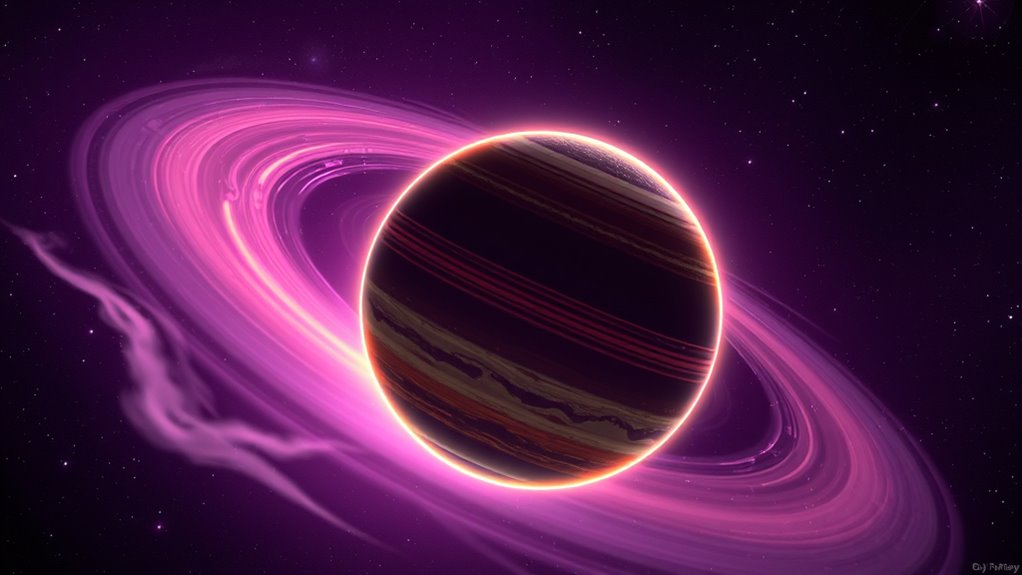Scientists have confirmed the first detection of an atmosphere around a distant exomoon, marking a major breakthrough. By using advanced telescope techniques like transit spectroscopy and light curve analysis, researchers identified faint atmospheric signatures despite significant observational challenges. This discovery reveals that exomoons can develop and retain atmospheres, opening new possibilities for habitability. To learn more about how this finding reshapes our understanding of planetary systems, keep exploring current breakthroughs in celestial research.
Key Takeaways
- The first detection of an exomoon atmosphere was achieved through advanced transit spectroscopy techniques.
- The exomoon exhibits a thin but stable atmosphere rich in water vapor and carbon dioxide.
- Observations revealed seasonal atmospheric changes, indicating dynamic surface-atmosphere interactions.
- The discovery utilized next-generation telescopes with high-resolution spectrographs and adaptive optics.
- This breakthrough demonstrates exomoons can develop and retain atmospheres, expanding understanding of their potential habitability.
The Significance of Detecting an Exomoon Atmosphere
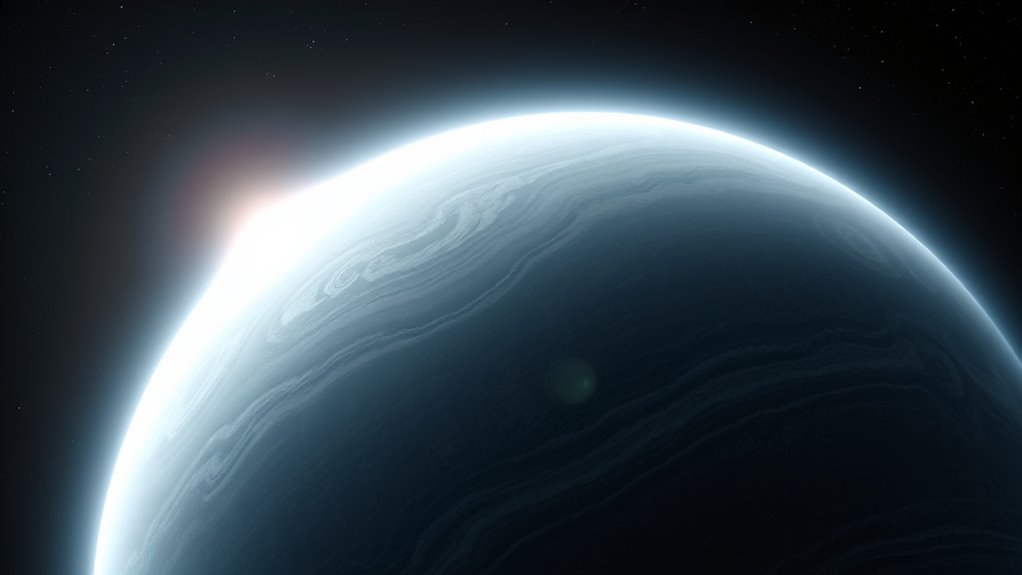
Detecting an exomoon atmosphere is a groundbreaking achievement because it opens new possibilities for understanding planetary systems beyond our own. This discovery sheds light on how exomoons form and evolve through complex gravitational interactions with their host planets. By studying the atmosphere, you gain insights into whether these moons can support conditions similar to those on planets, potentially hinting at habitability. The presence of an atmosphere suggests that exomoon formation involves processes like accretion and capture, influenced heavily by gravitational forces. Understanding these interactions helps you piece together the history and dynamics of distant systems. Additionally, this finding highlights the importance of advanced detection techniques in uncovering features of celestial bodies that were previously beyond our reach. Ultimately, this detection deepens your knowledge of the diversity and complexity of planetary systems, revealing that moons like these could be more than just satellites—they might host environments worth exploring.
Techniques Used to Observe Distant Exomoons
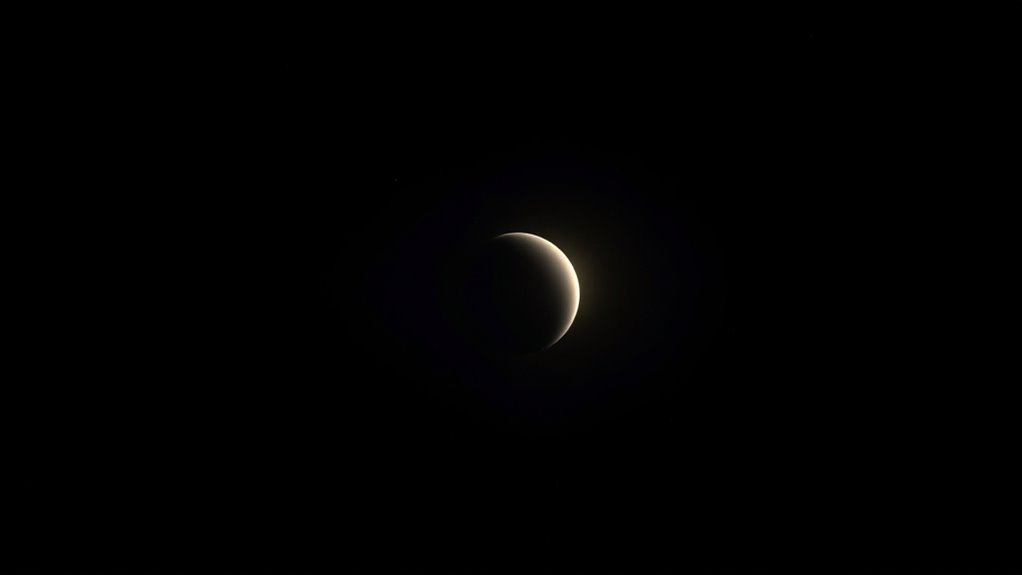
To study distant exomoons, scientists rely on techniques like transit spectroscopy and light curve analysis to detect subtle signals. You’ll find that direct imaging faces significant challenges due to the faintness and proximity of these objects. Understanding these methods is key to uncovering the atmospheres of worlds far beyond our reach.
Transit Spectroscopy Methods
Transit spectroscopy methods rely on analyzing the light from a star as a planet or exomoon passes in front of it, causing a slight dimming. During this process, some starlight filters through the exomoon’s atmosphere, revealing its composition. By studying the resulting spectral signatures, you can identify gases that relate to planetary formation processes and assess how orbital dynamics influence atmospheric retention. This technique requires precise measurements, as the signals are faint, but it offers direct insights into atmospheric constituents. You observe how specific wavelengths are absorbed, providing clues about the exomoon’s atmospheric layers. These observations help you understand the exomoon’s history, formation environment, and the role orbital interactions play in shaping its atmosphere. Overall, transit spectroscopy is a powerful tool for characterizing distant exomoons’ atmospheres, especially when combined with spectral analysis techniques that enhance detection sensitivity.
Light Curve Analysis Techniques
Light curve analysis techniques are fundamental for observing distant exomoons, building on the information gained from transit spectroscopy. By studying subtle dips and variations in brightness, you can detect signs of albedo variability, indicating surface or atmospheric changes. These variations help differentiate between moon and planet signals, revealing exomoon characteristics. Additionally, analyzing periodic fluctuations in the light curve can suggest a magnetic field, especially if star-planet-moon interactions cause detectable anomalies. You focus on precise measurements and pattern recognition to identify these signals amid noise. Advanced algorithms and statistical models enhance your ability to interpret complex light curves. Moreover, understanding the contrast ratio of your observations can improve the detection sensitivity for faint exomoon signals. Ultimately, these techniques give you critical insights into exomoon atmospheres, surfaces, and magnetic environments, expanding our understanding of distant worlds.
Direct Imaging Challenges
Observing distant exomoons through direct imaging presents significant challenges because their faint signals must be distinguished from the overwhelming brightness of their host stars. You need advanced techniques to suppress stellar glare, such as coronagraphs and starshades, which help reveal the exomoon’s faint light. Understanding planetary geology is essential, as it guides expectations about surface features and atmospheres that influence reflectivity. Orbital dynamics also play a key role, as exomoon positions and movements affect detection timing and imaging strategies. Achieving sufficient resolution requires powerful telescopes and adaptive optics to counteract atmospheric distortions. Despite these hurdles, ongoing technological innovations are gradually improving direct imaging capabilities, bringing distant exomoons into clearer focus and enabling detailed studies of their atmospheres. Incorporating high-precision instruments and electric bus technologies can further enhance observational efficiency and data collection in space telescopes.
The Role of Advanced Telescopes in Exomoon Research

Advanced telescopes considerably improve our ability to detect and study exomoons by offering enhanced detection capabilities. Recent spectroscopy advancements allow us to analyze their atmospheres in greater detail, revealing new insights. Future telescope missions promise even more precise observations, expanding our understanding of these distant worlds. Additionally, ongoing research into planetary atmospheres helps refine the techniques used to interpret spectral data from exomoons.
Enhanced Detection Capabilities
Thanks to recent innovations in telescope technology, scientists can now detect exomoons with unprecedented precision. These advanced telescopes allow us to observe subtle signals caused by exoplanet formation processes and stellar wind effects, which influence exomoon atmospheres. Enhanced detection capabilities make it possible to identify faint atmospheric signatures and distinguish exomoon signals from stellar noise. By improving sensitivity and resolution, we can track atmospheric changes over time and better understand how stellar winds strip or sustain exomoon atmospheres. These technological improvements also enable us to analyze the gravitational effects of exomoons more accurately, sharpening our ability to confirm their existence. Additionally, by expanding our understanding of evidence-based methods, we can develop more reliable techniques for studying distant celestial bodies. Overall, the latest telescopes expand our reach, making the study of distant exomoons more detailed and reliable than ever before.
Spectroscopy Advancements
Building on recent improvements in telescope sensitivity and resolution, spectroscopy advancements now play a pivotal role in exomoon research. These observational techniques allow you to analyze faint signals and identify atmospheric components with greater accuracy. Here are key developments:
- Enhanced spectrographs improve the detection of subtle atmospheric signals.
- High-resolution spectroscopy distinguishes exomoon atmospheres from host star interference.
- Adaptive optics reduce noise, sharpening spectral data.
- Data processing algorithms extract meaningful signals from weak or noisy observations.
- Proper storage of spectral data ensures long-term accuracy and reliability.
Together, these spectroscopy advancements enable you to better interpret exomoon atmospheres, revealing their composition and potential habitability. As telescopes become more sophisticated, your ability to explore distant worlds and their moons continues to grow, opening new frontiers in planetary science.
Future Telescope Missions
Future telescope missions will revolutionize exomoon research by providing unprecedented sensitivity and resolution. These advanced instruments will allow you to observe exomoon formation processes in greater detail, revealing how gravitational interactions influence their development. By capturing faint signals and subtle atmospheric signatures, you’ll better understand how exomoons acquire atmospheres and evolve over time. Upcoming telescopes, like the James Webb Space Telescope and planned next-generation observatories, are designed to detect atmospheric components and analyze their composition directly. This will enable you to study how gravitational interactions with host planets and star systems shape exomoon characteristics. Additionally, enhanced imaging techniques will help disentangle exomoon signals from their host systems, improving detection accuracy. Ultimately, these missions will deepen your insights into the complex dynamics of exomoon formation, atmospheric retention, and their potential habitability, opening new avenues in distant planetary system exploration.
Characteristics of the Discovered Atmosphere

The atmosphere around the exomoon displays a surprising level of complexity, offering vital clues about its composition and origin. Its characteristics reveal insights into exomoon geology and atmospheric pressure. You notice that:
- The atmosphere contains primarily volatile compounds like water vapor and carbon dioxide, indicating active geological processes.
- The measured atmospheric pressure is relatively low but stable, suggesting a thin, sustained envelope.
- Variations in gas composition hint at ongoing interactions between surface geology and the atmosphere.
- Spectroscopic data reveal seasonal changes, implying dynamic atmospheric chemistry.
- Attention to these details enhances understanding of how planetary atmospheres develop and evolve over time.
These features help you understand how the exomoon’s geology influences its atmosphere, providing a foundation for future habitability studies without delving into life potential just yet.
Implications for Habitability and Life Potential

The composition of the exomoon’s atmosphere offers clues about its potential to support life. Surface conditions and climate stability further influence whether the environment could sustain biological activity. Together, these factors help you understand the exomoon’s prospects for habitability and the possibility of life beyond Earth. Additionally, mechanical elements inspired by Victorian and steampunk aesthetics can be used to visualize or design concepts related to planetary environments and exploration.
Atmosphere Composition Insights
What does the composition of an exomoon’s atmosphere reveal about its potential to support life? It offers clues about its origin and habitability. For example, analyzing gases helps you understand exomoon formation processes and how gravitational interactions influence atmospheric retention. Consider these insights:
- High levels of water vapor suggest potential for life-supporting environments.
- Presence of oxygen indicates possible biological activity or atmospheric chemistry.
- Abundant methane could point to geological or biological sources.
- Composition dominated by noble gases might imply a primordial atmosphere, less likely to support life.
These details help you assess whether the exomoon’s atmosphere has remained stable over time, which is crucial for habitability prospects. Understanding atmosphere composition therefore directly informs the potential for life beyond Earth.
Surface Conditions and Climate
Understanding an exomoon’s atmospheric composition provides important clues about its surface conditions and climate, which are key factors in evaluating its habitability. A thick atmosphere suggests stable surface temperatures, possibly supporting liquid water. Geological processes like volcanic activity can influence surface features and climate stability. Magnetic fields protect the atmosphere from stellar winds, helping maintain surface conditions conducive to life. The table below highlights key factors:
| Factor | Effect on Surface Conditions | Significance for Habitability |
|---|---|---|
| Atmospheric Composition | Regulates temperature and radiation shielding | Determines climate stability |
| Geological Processes | Shape surface and release gases | Sustain surface renewal, climate cycles |
| Magnetic Fields | Protect atmosphere from stellar winds | Preserve surface conditions |
| Surface Temperature | Influences water state and habitability | Liquid water potential |
| Climate Stability | Ensures long-term habitability | Essential for life development |
Potential for Biological Activity
A detectable atmosphere around an exomoon considerably boosts its potential for supporting life, as it can provide essential conditions such as stable temperatures, protection from harmful radiation, and a medium for chemical reactions necessary for biological processes. This atmosphere may facilitate key aspects like exocean chemistry, where nutrients and organic molecules can form and interact. Additionally, the moon’s geology influences the potential for habitability by creating internal heat sources and subsurface oceans. The combination of these factors raises possibilities for life’s emergence. Here are some key points:
- The atmosphere enables complex chemical interactions essential for life.
- Moon geology may sustain liquid water through internal heating.
- Exocean chemistry could foster organic molecule synthesis.
- These elements collectively increase the likelihood of biological activity on the exomoon.
Challenges in Identifying Exomoon Atmospheres

Detecting atmospheres around exomoons presents significant challenges because their signals are often faint and difficult to distinguish from the noise of their host planets and stars. Gravitational interactions between moons and planets can produce subtle orbital shifts, but interpreting these signals requires precise measurements. Magnetic field detection is another hurdle; exomoons may generate weak magnetic signatures that are hard to separate from stellar activity or planetary fields. Additionally, the faintness of atmospheric absorption features makes it difficult to confirm their presence reliably. The combined effects of these factors mean that identifying exomoon atmospheres demands advanced observational techniques and careful analysis. Overcoming these challenges is essential to understanding the nature of these distant worlds and their potential habitability.
Comparing This Exomoon to Solar System Moons

While this exomoon shares some characteristics with moons in our Solar System, notable differences highlight its unique nature. First, its atmosphere suggests active processes like tidal heating, which likely drives geological activity more intensely than moons like Europa or Enceladus. Second, the presence of magnetic protection hints at a strong magnetic field, comparable to Ganymede, shielding it from stellar radiation. Third, its potential for sustaining an atmosphere indicates a balance between volcanic outgassing and atmospheric retention, unlike many distant moons. Fourth, its orbit around a distant exoplanet influences its tidal heating and magnetic environment differently, making it a fascinating comparison point. These factors reveal a dynamic, possibly more geologically active moon, setting it apart from familiar Solar System moons.
Future Missions and Technologies in Exomoon Exploration

Advances in telescope technology and propulsion systems are paving the way for groundbreaking missions to explore exomoons. Future missions will leverage improved sensitivity to detect planetary magnetospheres, revealing magnetic interactions that protect atmospheres. Technologies like gravitational microlensing will help identify exomoons around distant stars, expanding our search capabilities. You’ll see innovations such as high-precision spectrometers and advanced propulsion methods, enabling closer, more detailed observations. These tools will help answer fundamental questions about exomoon habitability and composition. Here’s a quick overview:
| Technology | Application | Impact |
|---|---|---|
| Planetary Magnetospheres | Studying magnetic fields | Understanding atmospheric protection |
| Gravitational Microlensing | Detecting distant exomoons | Expanding discovery range |
| Next-gen Telescopes | Imaging exomoon atmospheres | Improving resolution |
| Propulsion Systems | Long-range exploration | Increasing mission reach |
How This Discovery Changes Our Understanding of Planetary Systems
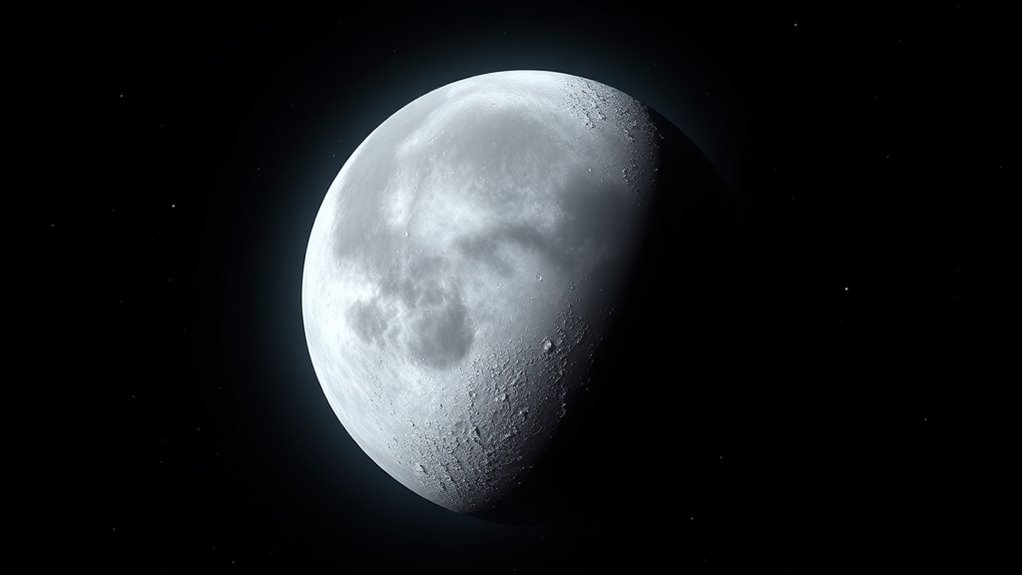
The discovery of an atmosphere around a distant exomoon markedly reshapes our view of how planetary systems form and evolve. It challenges existing ideas of exomoon formation, suggesting they can develop and retain atmospheres under diverse conditions. This impacts our understanding of orbital dynamics, revealing complex interactions that allow moons to hold onto gases even at great distances from their stars.
- You now see exomoon formation as more resilient and varied than previously thought.
- The role of orbital dynamics becomes clearer, highlighting the importance of gravitational interactions.
- It suggests moons could retain atmospheres longer, influencing planetary system evolution.
- These insights help refine models, guiding future searches for atmospheres and habitability.
Next Steps in the Search for Life Beyond Earth
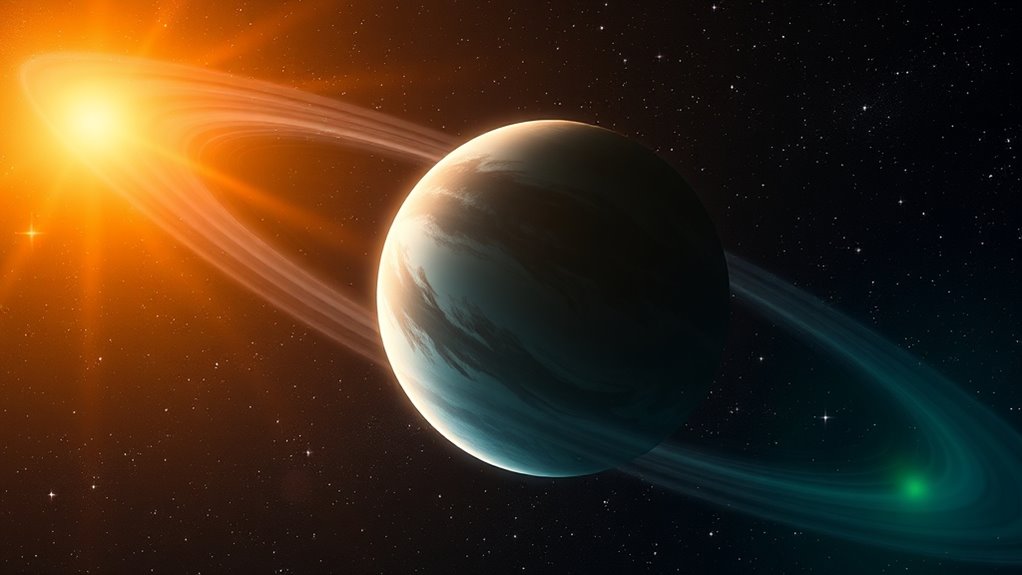
What are the most promising next steps in our quest to find life beyond Earth? Studying exoplanet atmospheres is vital, as they can reveal signs of habitability or biological activity. Future telescopes will improve our ability to analyze atmospheric composition, helping us identify biosignatures. We also need to understand stellar activity, since intense radiation from stars can strip atmospheres or mask signs of life. By monitoring stellar behavior, we can better assess which planets are viable candidates for habitability. Combining atmospheric data with star activity patterns will refine our search, increasing the chances of detecting life. These steps will move us closer to answering whether we’re alone, making the search for extraterrestrial life more targeted and effective.
Frequently Asked Questions
What Specific Gases Compose the Exomoon’s Atmosphere?
When considering the exomoon’s atmosphere, you might wonder about its composition. Atmospheric analysis reveals it’s mainly made up of hydrogen and helium, with traces of methane and water vapor. These gases suggest a primordial atmosphere, possibly shaped by volcanic activity and space weather. By studying its exomoon composition through spectroscopy, you can better understand its potential for habitability and the processes that formed this distant celestial body.
How Stable Is the Detected Atmosphere Over Time?
You wonder about the atmosphere’s long-term stability, and it’s likely variable over time due to external factors like stellar radiation and magnetic interactions. Atmosphere variability can cause fluctuations in composition and density, affecting its stability. While some exomoon atmospheres might persist for millions of years, others could dissipate faster. Monitoring these changes helps scientists understand the atmosphere’s long-term stability and its potential habitability.
Can the Atmosphere Indicate Potential Biosignatures?
Imagine the atmosphere as a subtle whisper from the exomoon, hinting at deeper stories. By analyzing its atmospheric composition, you can explore biosignature implications, revealing potential signs of life or conditions suitable for it. While it’s not definitive proof, the atmospheric clues guide your curiosity and investigations, helping you understand whether this distant world might harbor the ingredients or environments that suggest life, opening exciting possibilities for future discoveries.
What Are the Challenges in Confirming Exomoon Atmospheres?
You face significant spectroscopic challenges and observational limitations when confirming exomoon atmospheres. The faint signals are hard to detect amid stellar noise, requiring precise instruments and long observation times. These limitations make it difficult to distinguish genuine atmospheric features from background interference, complicating your efforts. Overcoming these hurdles involves advanced technology and careful data analysis, but even then, confirming exomoon atmospheres remains a complex and ongoing scientific challenge.
How Does This Discovery Influence the Search for Extraterrestrial Life?
This discovery markedly impacts your search for extraterrestrial life by expanding astrobiology implications, showing that moons can host atmospheres suitable for life. It encourages future exploration of exomoons, as their environments might be more habitable than previously thought. You’ll prioritize studying such worlds, understanding their atmospheres, and evaluating their potential for life, which could lead to groundbreaking breakthroughs in discovering extraterrestrial life beyond planets.
Conclusion
Imagine holding a tiny, distant world in your hands—this discovery is like finding a secret garden hidden on a moon far away. Detecting its atmosphere opens a new chapter in understanding where life might exist beyond Earth. Just as explorers once marveled at uncharted lands, scientists now uncover the mysteries of exomoons. With each breakthrough, you’re closer to answering whether life could thrive in these alien worlds, expanding the universe of possibilities in your mind.

